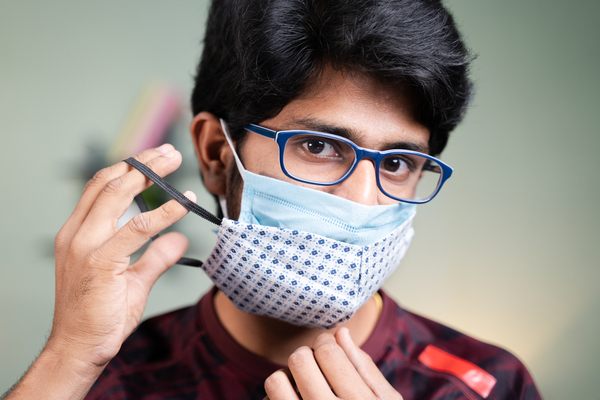The CDC now recommends double masking to prevent the spread of COVID-19, its first update to national face mask guidelines in months. The recommendation follows new CDC research, which shows that tight-fitting, multi-layer masks provide more protection against respiratory droplets, which drive the spread of COVID-19, than less secure options.
On Feb. 10, the CDC released research that found wearing cloth face coverings over surgical masks, as well as tying knots on the ear loops and tucking the sides of disposable masks, offers greater protection against COVID-19 than wearing a fabric covering or a poorly-fitted medical mask alone. Now, its national masking recommendations have been updated to match these findings.
The CDC study tested common face coverings in a lab setting to see how well they block respiratory particles. Researchers simulated coughing and breathing between pairs of dummies with no masks, three-ply surgical masks, three-ply cloth masks, cloth masks layered over surgical masks, and surgical masks with tied ear loops and tucked sides. The results suggest that fit and filtration should be optimized in every mask.
When an infected dummy coughed, unknotted medical masks and solo cloth masks kept just 42% and 44% of particles from escaping into the air, respectively; double masking blocked 93%. Exposure to droplets from an unmasked source was reduced by 65% with a knotted and tucked surgical mask and 83% with a double mask. When both dummies were wearing double or knotted and tucked surgical masks, droplet exposure dropped 96% from unmasked levels.
“Double masking adds an extra layer of filter, making it even more difficult for the drops of moisture ridden with the virus to get to you or to spread to others,” says Aline M. Holmes, D.N.P., R.N., a clinical associate professor at the Rutgers University School of Nursing. The same goes for creating a firm seal around the mouth, cheeks, and nose, which minimizes the amount of unfiltered air that is allowed to escape from (or into) your mask.
When you go into a public space, you almost never know which you’ll be—the infected person or the exposed person. Better-fitting masks and layered masks work remarkably well in both situations, especially when combined with social distancing and hand-washing, the other major tenets of disease prevention.
“There are three big pieces that are important when it comes to properly masking: multiple layers, a good fit, and wearing a mask consistently,” says Christopher Sulmonte, M.H.A., project administrator at the Johns Hopkins Biocontainment Unit, which cares for patients with highly contagious diseases. “By utilizing these in tandem, in a balance, they can be really effective in reducing the spread of COVID-19.”
—
Photo Credit: lakshmiprasada S / Shutterstock.com
